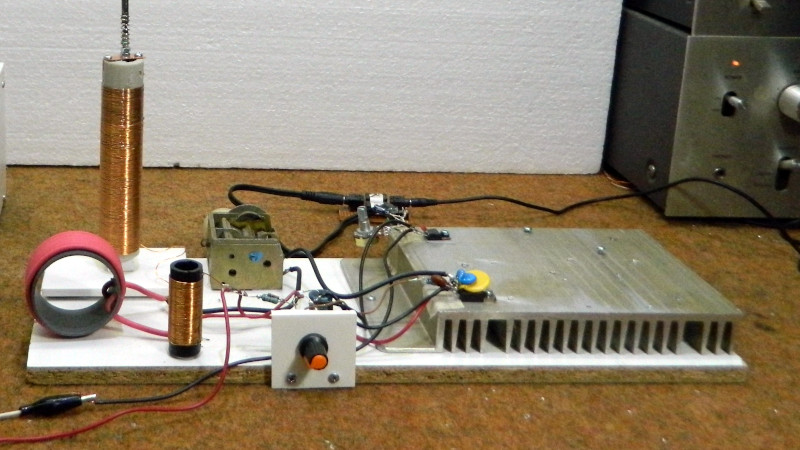When our ears resolve spatial information, we do so at the higher treble frequencies rather than the bass. Thus when setting up your home cinema you can put the subwoofer almost anywhere, but the main speakers have to project a good image. The theoretical perfect tweeter for spatial audio is a zero mass point source, something that a traditional speaker doesn’t quite achieve, but to which audio engineers have come much closer with the plasma tweeter. This produces sound by modulating a small ball of plasma produced through high-voltage discharge, and it’s this effect that [mircemk] has recreated with his HF plasma tweeter.
 A look at the circuit diagram and construction will probably elicit the response from most of you that it looks a lot like a Tesla coil, and in fact that’s exactly what it is without the usual large capacitor “hat” on top. This arrangement has been used for commercial plasma tweeters using both tubes and semiconductors, and differs somewhat from the singing Tesla coils you may have seen giving live performances in that it’s designed to maintain a consistent small volume of discharge rather than a spectacular lightning show to thrill an audience.
A look at the circuit diagram and construction will probably elicit the response from most of you that it looks a lot like a Tesla coil, and in fact that’s exactly what it is without the usual large capacitor “hat” on top. This arrangement has been used for commercial plasma tweeters using both tubes and semiconductors, and differs somewhat from the singing Tesla coils you may have seen giving live performances in that it’s designed to maintain a consistent small volume of discharge rather than a spectacular lightning show to thrill an audience.
You can see it in operation in the video below the break, and it’s obvious that this is more of a benchtop demonstration than a final product with RF shielding, It’s not the most efficient of devices either, but given that audiophiles will stop at nothing in their pursuit of listening quality, we’d guess that’s a small price to pay. Efficiency can be improved with a flyback design, but for the ultimate in showing off how about a ring magnet to create the illusion of a plasma sheet?















One of the many problems with plasma tweeters is that the flame produces a continuous noise that gets mixed with the music. It’s hard to tell in this video because it seems like there’s a fan running in the power supply or an air conditioner in the room (or the mic that’s recording has a really bad noise floor).
That and the ozone.
Which corrodes both stainless steel and human tissue. Good stuff
Yeah, even though on paper it supposed to be perfect sound source: no mechanical parts or enclosue so resonance cannot occur, air is moved by ionized air.
A point source would cause problems. Air is nonlinear, so the high relative pressure changes in the tiny area around a point would cause distortion. Also, a small radiating area means poor efficiency. The relations between size, efficiency, bandwidth, frequency, distortion, etc. are fairly complex, which is why making very high quality economical speaker designs is not a trivial task.
The definition is a bit of both, it’s tricky to classifiy these things but there’s some decent info here https://massless.info/Types.html .